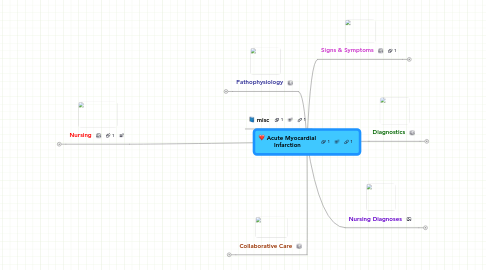
1. Pathophysiology
1.1. Ischemia to myocardium
1.1.1. Thrombus
1.1.2. Embolus
1.1.3. Vasospasm
2. Collaborative Care
2.1. rapid diagnosis
2.2. preserve cardiac muscle
2.2.1. reperfusion therapy
2.2.1.1. fibrinolytic therapy
2.2.1.1.1. tissue plasminogen activator (tPA)
2.2.1.1.2. streptokinase
2.2.1.1.3. reteplase (Retavase)
2.2.1.2. emergent percutaneous coronary intervention (PCI)
2.3. drug therapy
2.3.1. nitrates
2.3.2. B-adrenergic blockers
2.3.3. systemic anticoagulation
2.3.3.1. SQ or IV low-molecular-weight heparin
2.3.4. antiplatelets
2.3.4.1. aspirin
2.3.5. calcium channel blockers
2.3.6. morphine
2.4. emergent CABG surgery
3. Nursing
3.1. Monitor
3.1.1. premature ventricular contractions
3.1.2. ventricular tachycardia
3.1.3. ventricular fibrillation
3.2. O2
3.3. IV
3.4. VS's, I&O
3.5. Medication
3.5.1. Morphine
3.5.2. ASA
3.5.3. Thromboltyics
3.5.3.1. TPA
3.5.3.2. Strepto
3.5.4. Heparin
3.5.5. Nitrates
3.5.6. Antidysrythmics
3.6. pain assement & relief
3.6.1. nitroglycerine
3.6.2. morphine
3.6.3. supplemental oxygen
3.7. anxiety
4. misc
5. Signs & Symptoms
5.1. chest pain
5.2. shortness of breath
5.3. fatigue
5.4. weakness
5.5. nausea & vomiting
5.6. pallor & diaphoresis
6. Diagnostics
6.1. ECG
6.2. serum cardiac markers
6.2.1. creatine kinase (CK-MB)
6.2.2. troponin
